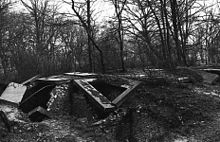Stone gate cemeteries
As Steintor cemeteries were in Hamburg the east front of the stone gate and thus outside the narrow fortification situated burial grounds referred. Like the Dammtorfriedhöfe , they were laid out at the turn of the 18th and 19th centuries and 100 years later had to give way to the construction of Hamburg's main train station .
history
The reason for the construction of the new burial places was the overcrowding and the resulting hygienic problems in the inner-city church yards. Since the 1770s, there have been various attempts to relocate the tombs outside the city walls. In addition, the Hamburg upper class, in the course of romantic devotion to nature ( Klopstock !), Increasingly went over to having themselves buried in scenic village cemeteries in the vicinity (especially in Hamm , Niendorf and Nienstedten ), which meant that the Hamburg city churches lost significant income . With their park-like layout, these cemeteries also served as models for the new burial grounds.
As the first of the hamburger main churches therefore had St. Jacobi in 1793 from a previously-used already as poor cemetery grounds in front of the stone gate as a new burial ground. While the other main churches laid out their cemeteries in front of the Dammtor , another burial place for the St. George suburb followed in front of the Steintor in 1803 . Also in front of the Steintor, but a little further away on the "Grosse Allee" (today Adenauerallee), there was initially a common cemetery for the Reformed parishes of Hamburg, but in 1825 it was moved to the Dammtor.
In the middle of the 19th century, however, the new cemeteries already proved to be too small for the rapidly growing city population. For this reason, burials in both cemeteries were restricted again after a new St. Jacobi cemetery had been inaugurated on Peterskamp in Eilbek (today's Jacobipark ) in 1848 . After the opening of the Ohlsdorf Central Cemetery in 1877, the Steintorfriedhöfe were finally closed and the site was sold to the Free and Hanseatic City of Hamburg. In the 1890s it was finally cleared for the construction of Hamburg Central Station. While the surviving bones were mostly burned, numerous tombstones were given a new museum location in Ohlsdorf.
See also
literature
- Eberhard K Händler: burial grove and crypt. The tombs of the upper class in the old Hamburg cemeteries . Christians Verlag Hamburg 1997 ISBN 3-7672-1294-3
- Barbara Leisner, Norbert Fischer : The cemetery guide. Walks to known and unknown graves in Hamburg and the surrounding area. Christians Verlag, Hamburg 1994, ISBN 3-7672-1215-3 .
Individual evidence
- ↑ Kellers p. 20.
- ↑ Kellers p. 40, 43.
- ↑ Kellers p. 46 ff.
- ↑ Kellers p. 36.
- ↑ Leisner / Fischer p. 38.
- ↑ Kellers p. 44; Leisner / Fischer p. 44 ff.
Coordinates: 53 ° 33 '12 " N , 10 ° 0' 24.3" E



